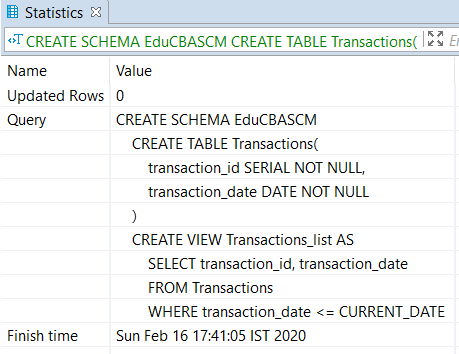

#On delete cascade postgres how to
no idea how to choose the bulk size value.
#On delete cascade postgres Patch
no idea where to monkey patch for global usage.It worked great in our case: we used it in a migration. MethodType (limited_bulk_batch_size, connection. 'DELETE FROM x WHERE x.y IN (.large list.)'Ĭonnection. PostgreSQL can crash with too many parameters in a queryĮ.g. Import types def monkey_patch_connection_bulk_batch_size (connection ): def limited_bulk_batch_size ( self, fields, objs ): """ This was fixed in django 1.8 by adding batch query #link1, #link2 with a size specified per backend:Īs a temporary workaround we monkey patched the connection instance own bulk_batch_size and limit to 64k. In fact this pattern already lead to an issue with the sqlite backend ( #link0: sqlite supports only 999 parameters per query) It seems the related objects A get deleted in one query with an unbound IN (.) list of B objects. with a smaller database it worked (2M rows).It can't accumulate the pending-deletion keys in a tuplestore. : db=,user= DETAIL: Failed process was running: DELETE FROM "a" WHERE "a"."b_id" IN (17271, 17272, 17273, 17274, 17275, PostgreSQL (or at least 9.6 and oler) is not smart enough to batch up keys to delete and do a single big DELETE FROM. : db=,user= LOG: server process (PID 12911) was terminated by signal 9: Killed when there are many B objects to delete (in our case it was 14M rows), the database process gets killed before completion: Re: How to REMOVE an 'on delete cascade' You can do all that in a single sql command.Model A has a foreign key to model B with on_delete=CASCADE.The expression can use any column names of the table named by table_name or table(s) listed in USING. output_expressionĪn expression to be computed and returned by the DELETE command after each row is deleted. See DECLARE for more information about using cursors with WHERE CURRENT OF. Note that WHERE CURRENT OF cannot be specified together with a Boolean condition. The cursor must be a non-grouping query on the DELETE's target table. The row to be deleted is the one most recently fetched from this cursor. The name of the cursor to use in a WHERE CURRENT OF condition. Only rows for which this expression returns true will be deleted. conditionĪn expression that returns a value of type boolean. Postgres taking 3h to DELETE CASCADE Ask Question Asked 4 years, 9 months ago Modified 4 years, 9 months ago Viewed 4k times 0 I have a Postgresql 9.3 with a 'mother' table containing items, and a number of 'child' tables containing parts of different kinds (e.g. Do not repeat the target table as a from_item unless you wish to set up a self-join (in which case it must appear with an alias in the from_item). This uses the same syntax as the FROM clause of a SELECT statement for example, an alias for the table name can be specified. from_itemĪ table expression allowing columns from other tables to appear in the WHERE condition. For example, given DELETE FROM foo AS f, the remainder of the DELETE statement must refer to this table as f not foo. When an alias is provided, it completely hides the actual name of the table.

aliasĪ substitute name for the target table. Optionally, * can be specified after the table name to explicitly indicate that descendant tables are included. If ONLY is not specified, matching rows are also deleted from any tables inheriting from the named table. If ONLY is specified before the table name, matching rows are deleted from the named table only. The name (optionally schema-qualified) of the table to delete rows from. The WITH clause allows you to specify one or more subqueries that can be referenced by name in the DELETE query.


 0 kommentar(er)
0 kommentar(er)
